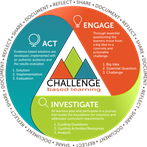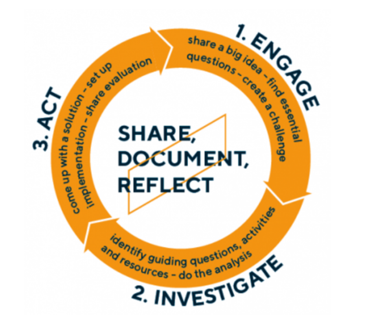Challeng e-Based Learning (CBL) is a pedagogical approach that actively engages students in a situation that is real, relevant and related to their environment. Core to CBL is that learning is driven by challenging, open-ended problems that have multiple solutions.
e-Based Learning (CBL) is a pedagogical approach that actively engages students in a situation that is real, relevant and related to their environment. Core to CBL is that learning is driven by challenging, open-ended problems that have multiple solutions.
CBL is student-driven; teachers do not dictate the learning activities at the outset nor do they fully define the individual learning goals of students, as in traditional education. Instead, students define their own challenges (the problems they want to work on) and acquire the necessary knowledge and skills to solve this challenge. As such, CBL is very motivating for students as it offers them authentic learning experiences that allow them to explore, discuss, and meaningfully construct concepts and relationships in contexts that involve real-life challenges and projects that are relevant to the students. Students thus are co-designers of their own learning and development.
Why Challenge-Based Learning
Many of today’s problems cannot be solved by one discipline alone. These problems require a multidisciplinary approach, where solutions require technical and also social perspectives and understanding. This means that future graduates must know how technical solutions function in the real world and that they can identify connections across boundaries between disciplines. In addition, with changes in the world taking place at an ever-increasing speed, future graduates can no longer rely on their education to be sufficient throughout their careers. Instead, they will need to update their knowledge and skills continuously, which requires the development of learning skills
The CBL approach prepares students for this dynamic, complex, and unpredictable future work field. In CBL, students work in multidisciplinary teams when working on the challenge, thus improving their team working skills. The students have to define themselves which knowledge they need to acquire to solve the problem and to actually apply this new knowledge when designing their solution. As a result, they develop their self-steering and learning skills. As the solution can be environmentally, socially and economically sustainable, students learn to define and combine different (disciplinary) perspectives.
Unique aspects of CBL
As student teams define their own challenge to work on, this automatically means that the outcome is not predictable, the process determines the direction. Students enter the real world, involving all stakeholders and community members necessary in the process. Furthermore, the students must publish the outcomes of each step to receive feedback and learn from mistakes (Observatory of Educational Innovation, 2015). Failures are therefore part of the learning experience, not only for the student but also for the stakeholders involved because failures urge reflection and thought – which in turn stimulates the learning of the students.
Another unique aspect of challenge-based learning is that it does not assume that there is always a problem to be solved; it is about recognizing challenges and finding new solutions and opportunities. This even could mean the students come up with a solution to a problem the stakeholder did not realize he had.
CBL Framework: three main phases
The Challenge Based Learning Framework is divided into three interconnected phases:
- Engage (in which the Learners move from an abstract big idea to a concrete and
 actionable challenge),
actionable challenge), - Investigate (in which Learners conduct research to create a foundation for actionable and sustainable solutions) and
- Act (in which evidence-based solutions are developed and implemented with an authentic audience and the results evaluated).
Each phase includes activities that prepare students to move to the next phase. Within each of the phases, there are opportunities for mini-investigation cycles and if necessary a return to an earlier step or sometimes even an earlier phase. Part of the entire process is that students continuously document, reflect and share their learning experiences and findings.
CBL Framework in more detail
The Challenge-based learning approach follows a specific structure. Each of the three phases has three sub-steps.
Phase 1: ENGAGE
The engagement phase begins with a Big Idea (1.1). This is a broad theme or concept that can be explored in multiple ways and is often important to the learner and a larger community, for example, health, public transportation, sustainable development, green energy etc. Next, all the participants, teachers, students and external partners work together to define Essential Questions (1.2) – questions you can ask when discussing the Big Idea. Based on the discussion, the group of learners decides on the question they want to investigate further and translate this into a concrete and Actionable Challenge (1.3). This Actionable Challenge turns the final question into a call to action to learn deeply about the subject and to find a solution.
Phase 2: INVESTIGATE
The Investigation phase makes sure all participants of the challenge contribute with their knowledge and skills and conduct activities to create a foundation for actionable and sustainable solutions. It starts with Guiding Questions (2.1), to find out what (additional) knowledge is needed to analyze and solve the challenge. Then the group finds supporting Resources and Activities to find the additional knowledge (2.2). Activities could include: simulations, experiments, projects, problem sets, research, and games. The Investigation phase concludes with a Synthesis (2.3), an analysis of all the information found. In the end, the group demonstrates that they have successfully addressed all of the questions and developed clear conclusions that will set the foundation for the solution.
Phase 3: ACT
Solutions are developed and implemented with an authentic audience and the results are evaluated in Action phase. The teams use gained and shared knowledge to actually design and prototype new solutions, in two steps: Solution Concepts (3.1), in which the learners make a first draft of their solution; and the Solution Development (3.2), in which the team actually designs a prototype and tests it. In this design cycle often new guiding questions arise, which can well lead to further investigation (Phase 2). In the final step, Implementation and Evaluation (3.3), the design is tested in real life and evaluated on the impact it has on the challenge and society. Important in this step is that the learners also reflect on the whole process.
Different formats of CBL
Challenges – whether they are called hackathons, competitions or design projects – are activities that challenge students of all levels to solve difficult problems and can serve as a powerful tool for education and engagement. They provide an incentive to advance technical and mathematical skills and enhance teamwork and effective communication, so-called 21st-century skills.
Different formats are possible. Examples of formats are presented by the following four dimensions:
- duration and workload (which is indicated by the clock in the figure below)
- level of engagement, that is the starting point when student teams enter the challenge (which is indicated by the eye in the figure below)
- level of investigation, that is level of research and variety of activities to find a solution (which is indicated by the loupe in the figure below)
- level of action, that is the way to open the findings for society (which is indicated by the target in the figure below)

Mini- and Standard Challenges (Source unknow.) Also see: CBL guide - digital promise and the challenge institute, 2016
Some sources also talk about a Nano-challenge, a project of 1 or 2 days. Student teams start with a given challenge, will take all the steps in the Investigate phase, and will design a Solution (step 7 of the CBL model). Although this can work well in situations with limited available time (like hackathons) and will be motivating for students, we prefer to use the term CBL for the mini and standard challenge, as in these two situations students are responsible for the important steps of Essential Questions and Define Actionable Challenge (in phase 1 – Engage) and the step Implementation and Evaluation (in phase 3 – Act) – steps that are very important in CBL.

